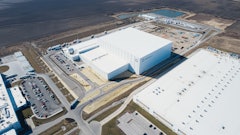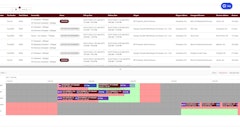
JTM's switch from manual cold storage warehousing to an AS/RS significantly cut costs.
The vast majority of cold storage warehouses in the United States are large, cavernous buildings with ceilings 20 feet high and multiple 12-foot-wide aisles with fork trucks riding in and out of them moving product up and down from the racks.
Compared to non-freezer facilities, cold storage warehouses have a higher incidence of product damage, missed product rotation and wrong item fulfillment. They also have heightened facility and equipment damage, primarily caused from fort lifts impacting racks and doors, significantly higher than what is found in non-freezers. Personnel turnover in cold storage facilities is also higher than in non-freezer warehouses.
Cold storage warehouses pose definite challenges to operations and logistics managers who endeavor to have facilities operating at a high level of efficiency. Where a 99th percentile inventory and fulfillment accuracy rate could be expected in a non-freezer warehouse, it becomes patently unrealistic at 10 degrees F below zero. That is, unless the warehouse has an automated storage and retrieval system in place.
An automated storage and retrieval system (AS/RS) is a computer-controlled system for automatically depositing, inventorying and retrieving loads from defined storage locations. It allows inventory to be moved quickly, safely and precisely in a warehouse environment. When applied to a sub-zero warehouse, AS/RS produces dramatic results, effectively making the cold storage facility as efficient as an automated non-freezer warehouse.
In addition, in a typical cold storage warehouse where fork lifts are used, the lift’s maximum reach is around 20 feet, allowing about four vertical pallet positions for a maximum 20-foot rack height. With an AS/RS facility, it is common to have as many as 12 vertical pallet positions on 80-foot racks and higher.
In a non-freezer warehouse this is an important efficiency factor in footprint consolidation. In a cold storage warehouse, the footprint reduction becomes an absolutely critical factor in energy savings since much of the heat gain occurs in the roof.
In effect, cold storage warehouses are giant insulated freezers which extract heat to produce a cold environment. The removal of heat comes at a hefty energy cost, and incidentally, significantly more than what it takes to put heat into a space. Since most heat gain occurs through the roof, having a smaller roof footprint from a cold storage warehouse presents a better energy solution.
It can handle the same number of pallets, but in a smaller footprint. A cold storage facility with an AS/RS could reduce energy costs to one-third of that needed for a manual facility. Such was the case with JTM Food Group, which switched from a manual cold storage facility to one operated with an AS/RS.
JTM GOES WITH AS/RS
JTM Food Group, located in Harrison, OH, is a family-owned food processor producing such products as meat balls, sausage links, Angus beef chili and hoagie buns. All of the company’s products are cooked, packaged and distributed from its own plant.
Since the late 1960s, when the company first operated as a modest retail meat shop in Cincinnati, it has grown into a prominent meat processor with sales exceeding $72 million in 2007. JTM’s plant runs a kettle cooking line, a grind and form line and a bakery line within its facility, operating as a specialty manufacturer of more than 1,000 items. One hundred percent of what JTM sells is frozen. Fifty percent of the company’s products go to school lunch programs while 35 percent of its sales go to restaurants, and 15 percent of its products go to supermarkets and grocery stores as packaged products for shelf sales.
To handle this huge product volume, JTM constructed a 20,000 square-foot, minus 10 degrees F, cold storage warehouse with 10,000 high-bay pallet locations serviced by an AS/RS. But like most other meat processors inventorying frozen product, JTM struggled for many years with the limitations of inefficient cold storage facilities.
“We had been building new storage freezers every couple of years since we started the business,” says Joe Maas, JTM’s vice president of operations. “We were getting tired of the same size and type of storage freezers, so this last time we built a really big one, with 10,000 pallet locations, so that it would have take care of our needs for many years. We were operating with two 700-pallet storage freezers and using outside storage and wanted to increase our efficiency by consolidating the freezers into one space and manage all inventory internally on location at the plant.
“Taking up land space was another problem that we were trying to overcome,” continues Maas. “Another is that freezers are quite expensive to build and operate, so we wanted to minimize aisle space. Aisles are dead space; no product is stored in aisles. We tried to come up with ways to minimize aisle cubic footage so to maximize pallet positions, and make it more reasonable to build.
“One of the problems with freezers is fork lifts driving right through the door,” explains Maas. “Not only do fork lifts let out a tremendous amount of cold air from the freezer, they also create a lot of damage to the racking, doors and product. So another goal of mine was to get rid of fork lifts on my entire shipping and receiving docks. I wanted to design a freezer that was as efficient as possible, and operated by as few people as possible. I looked extensively, then found the automated pallet storage and retrieval system.”
The roof square footage with an AS/RS is small, Maas says. “Most of our heat gain is going to occur in the roof, so the AS/RS design minimizes that. It has a single extremely narrow five-foot wide aisle, as opposed to several 12-foot wide aisles on non-AS/RS freezers. Also, there are no large doors that open. The doors are smaller, and they only open when product needs to go in and out, and only as long as necessary to take in a pallet, then it shuts immediately behind, it is all automated. The door is only the size of the pallet.
“Our AS/RS doors are six feet high and four feet wide, and when the product is passing through the door it blocks air from getting out. Then the door shuts immediately. A standard freezer with a fork lift has an eight-foot by 10-foot opening and the door closes sometime after the truck passes through, but slowly, releasing a lot of cold air,” says Maas.
DOUBLE-LOAD PALLET HANDLING
JTM selected Grand Rapids, MI-based Dematic Corp. to design and build the storage retrieval system, including control software, racking and conveying equipment.
Dematic designed the system with a unique double-load remote pallet handling device which can carry two pallets at a time, instead of the classic AS/RS machine that typically handles one pallet at a time. When JTM’s storage retrieval machine picks up loads that are coming out of manufacturing it loads up two pallets at a time and then puts away two pallets at a time, which decreases the cycle time of the machine and increases throughput.
When the pallet is on the load handling device it is carried off the AS/RS machine into the rack. It performs a function called deep lane storage. When that AS/RS machine runs up and down the aisle, on one side it can handle four-deep pallet storage lanes, and on the other side it can handle eight pallet-deep storage lanes. A conventional AS/RS machine only goes one-, two- or three-pallets deep, using a fork attached to the machine, because that is the maximum it can reach. But with the Dematic drive-off remote, it can run a pallet 30 feet off into the eight-deep side and drop it into storage, and then return back to the AS/RS machine.
“JTM can do an entire production run of hamburger patties that are all the same lot, the same SKU, for example,” says Mike Khodl with Dematic. “So, they can store eight pallets deep and still access the same lot number, the same run of product.”
“One of the key aspects of the project was that Dematic designed the order picking stations outside of the freezer environment,” continues Khodl. “That has really helped on turnover with people doing that job before in the freezer.”
“Dematic also integrated StagingDirector, for inventory management and pallet movement with the AS/RS, part of the Dematic WCS (Warehouse Control System) IT Suite,” explains Khodl. “When JTM gives StagingDirector an order, it knows where it stored that palletized SKU, goes in and gets it, and brings it out to a workstation. JTM personnel then pick off the cases they need to fulfill the order, the pallet goes back into the system, and it knows where it put it again. It knows how many cases are left on that pallet after they pick the cases off. This information then ties in with JTM’s order management system.”
END RESULTS
The AS/RS eliminated the excess air exchange in and out of the freezer, making it more efficient and reducing energy costs. JTM also lost all of the cost associated with the maintenance of fork lifts, and the labor and travel time associated with physically operating them. Now, JTM’s order pickers are more efficient and more productive, they simply push a button and out comes the SKUs they need, and they just pick right to the order pallet.
“My refrigeration engineer shakes his head every time we look at the freezer,” explains Maas. “It uses one-third of the refrigeration we felt it was going to need based on our prior experience with non-AS/RS freezers that would hold 10,000 pallets, and based on everything we knew prior. We originally built in two compressors, but only one of them ever comes on because the other is not needed.”
JTM built the freezer big enough so it could rent out the additional space until it needed it, so, the company does third-party retail logistics work out of its freezer. It has all of its product, as well as other company’s product in its freezer. It made it more affordable for a small company like JTM to take advantage of this level of automation.
Another benefit of the AS/RS is the security of the product in the freezer. “Our level of security is incredible,” says Maas. “Since no one goes in the freezer, the products are more secure from pilferage and tampering.”



























